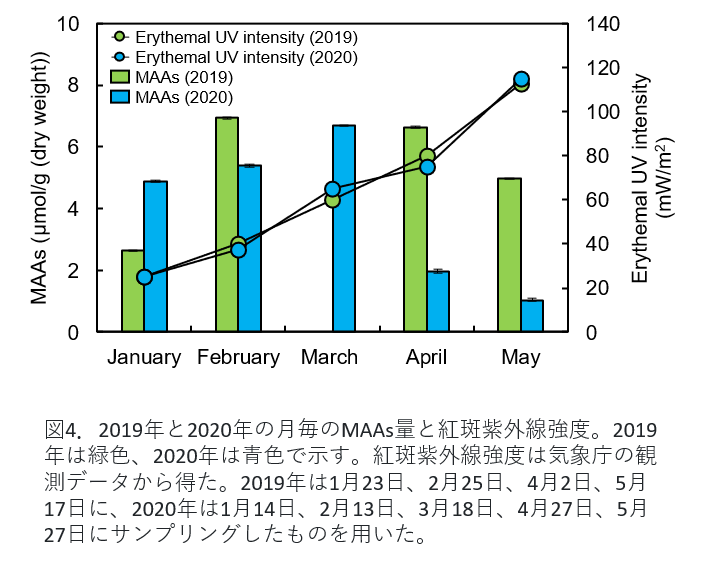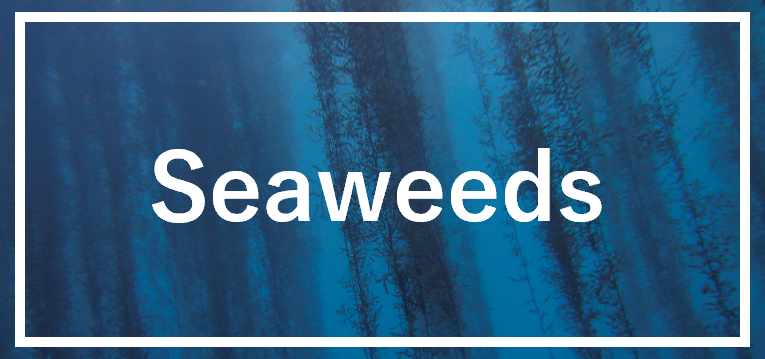Search for health functional ingredients in red algae, a low-use resource; Development of preparation method for UV protective substances
Diagrama de temas
-
Seaweeds, like plants, cannot move freely. Therefore, red algae growing in the intertidal zone are constantly exposed to ultraviolet radiation. Red algae contain mycosporin-like amino acids (MAAs), which act as UV-protectants. As such, they are environmentally friendly compounds, but because of their strong UV-protective properties, they are found only in small amounts in red algae.
In this study, we investigated preparation methods and when samples are best to efficiently obtain MAAs from the low-utilized resource red alga Dulse (Figure 1).

-
MAAs are water-soluble low molecular weight compounds synthesized by the shikimic acid and pentose phosphate pathways and are secondary metabolites with cyclohexanone and cyclohexceimine as their basic backbone (Figure 2). Sunlight contains ultraviolet rays that are harmful to living organisms. Ultraviolet radiation is classified into UVA (315-400 nm), UVB (280-315 nm), and UVC (100-280 nm) according to its wavelength range. UVA and UVB reach the earth's surface and cause structural changes in proteins and nucleic acids, while MAAs have absorption maxima between 310 and 360 nm and emit light energy as heat.
Shikimic acid pathway: A pathway by which microorganisms and plants biosynthesize aromatic amino acids (tyrosine, phenylalanine, tryptophan).
Pentose phosphate pathway: A pathway in the glycolytic system mainly involved in the biosynthesis of five-carbon sugars (ribose and deoxyribose).

Figure 2. (A), Cyclohexenone; (B), Cyclohexaymin -
Polysaccharides such as agar and carrageenan are major components of red algae. Because of the high viscosity of the polysaccharides in seaweeds, it was difficult to recover the water-soluble MAAs because they turned into a sludge when extracted with water. Therefore, it was necessary to precipitate the polysaccharides by adding an organic solvent. On the other hand, the polysaccharide xylan of dulse has been found to be less viscous than other red algae polysaccharides. Therefore, we developed an extraction method of MAAs suitable for dulse. When MAAs were extracted under conditions optimized for dulse, six peaks were detected by high-performance liquid chromatography (Figure 3).

Signal intensity (mV)
Time (min)
Acetonitrile concentration (%)
Figure 3. Separation of MAAs by high-performance liquid chromatography. Chromatograms at 330 nm absorption wavelength.1, Shinorine; 2, Palythine; 3, Asterina-330; 4, Porphyra-334; 5, Usujirene; 6, Palythene. -
The composition of seaweeds fluctuates greatly depending on the time of year. We investigated the amount of MAAs in the samples from January to May in 2019 and 2020 (Fig. 4), based on the idea that the amount of MAAs may also change depending on the time of year.
The results showed that the amount of MAAs increased from February to March in both years. We also found a gradual decrease after March.
We believe that one of the reasons for this is that the amount of ultraviolet radiation increases as we move toward summer. The sampling site is located near Eruption Bay. Eruption Bay is known to be depleted of nutrients and other substances due to the spring bloom that occurs every year when diatoms proliferate due to ocean currents. Therefore, it was thought that the amount of MAAs might be decreasing due to nutrient depletion despite the increase in UV radiation.
Figure 4. Monthly MAAs amounts and erythema UV intensity for 2019 and 2020, shown in green for 2019 and blue for 2020. Erythema UV intensity was obtained from JMA data. The data were sampled on January 23, February 25, April 2, and May 17 for 2019 and on January 14, February 13, March 18, April 27, and May 27 for 2020.
-
(Open Access) Nishida et al. Efficient Extraction and Antioxidant Capacity of Mycosporine-Like Amino Acids from Red Alga Dulse Palmaria palmata in Japan. doi.org/10.3390/md18100502
(Open Access) Nishida et al. Monthly Variation and Ultraviolet Stability of Mycosporine-Like Amino Acids from Red Alga Dulse Palmaria palmata in Japan. doi.org/10.3390/phycology1020009
-
Exploring Functional Properties of MAAs Other Than UV Protection
Search for red algae rich in MAAs



